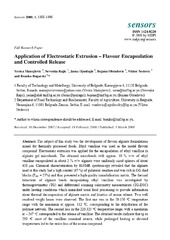Application of electrostatic extrusion - Flavour encapsulation and controlled release
2008
Аутори
Manojlović, Verica
Rajić, Nevenka

Đonlagić, Jasna

Obradović, Bojana

Nedović, Viktor

Bugarski, Branko

Чланак у часопису (Објављена верзија)
CC BY
Метаподаци
Приказ свих података о документуАпстракт
The subject of this study was the development of flavour alginate formulations aimed for thermally processed foods. Ethyl vanilline was used as the model flavour compound. Electrostatic extrusion was applied for the encapsulation of ethyl vanilline in alginate gel microbeads. The obtained microbeads with approx. 10 % w/w of ethyl vanilline encapsulated in about 2 % w/w alginate were uniformly sized spheres of about 450 mu m. Chemical characterization by H-NMR spectroscopy revealed that the alginate used in this study had a high content ( 67 %) of guluronic residues and was rich in GG diad blocks (F-GG = 55%) and thus presented a high-quality immobilisation matrix. The thermal behaviour of alginate beads encapsulating ethyl vanilline was investigated by thermogravimetric (TG) and differential scanning calorimetry measurements (TG-DSC) under heating conditions which mimicked usual food processing to provide information about thermal decomposition of alginate matrix and kinetics of aroma ...release. Two well resolved weight losses were observed. The first one was in the 50-150 degrees C temperature range with the maximum at approx. 112 C, corresponding to the dehydration of the polymer network. The second loss in the 220-325 degrees C temperature range, with a maximum at similar to 247 degrees C corresponded to the release of vanilline. The obtained results indicate that up to 230 degrees C most of the vanilline remained intacta, while prolonged heating at elevated temperatures led to the entire loss of the aroma compound.
Кључне речи:
electrostatic extrusion / ethyl vanillin / flavour encapsulation / TG-DSCИзвор:
Sensors, 2008, 8, 3, 1488-1496Издавач:
- MDPI, Basel
DOI: 10.3390/s8031488
ISSN: 1424-3210
PubMed: 27879775
WoS: 000254340700006
Scopus: 2-s2.0-41549091001
Институција/група
Tehnološko-metalurški fakultetTY - JOUR AU - Manojlović, Verica AU - Rajić, Nevenka AU - Đonlagić, Jasna AU - Obradović, Bojana AU - Nedović, Viktor AU - Bugarski, Branko PY - 2008 UR - http://TechnoRep.tmf.bg.ac.rs/handle/123456789/1318 AB - The subject of this study was the development of flavour alginate formulations aimed for thermally processed foods. Ethyl vanilline was used as the model flavour compound. Electrostatic extrusion was applied for the encapsulation of ethyl vanilline in alginate gel microbeads. The obtained microbeads with approx. 10 % w/w of ethyl vanilline encapsulated in about 2 % w/w alginate were uniformly sized spheres of about 450 mu m. Chemical characterization by H-NMR spectroscopy revealed that the alginate used in this study had a high content ( 67 %) of guluronic residues and was rich in GG diad blocks (F-GG = 55%) and thus presented a high-quality immobilisation matrix. The thermal behaviour of alginate beads encapsulating ethyl vanilline was investigated by thermogravimetric (TG) and differential scanning calorimetry measurements (TG-DSC) under heating conditions which mimicked usual food processing to provide information about thermal decomposition of alginate matrix and kinetics of aroma release. Two well resolved weight losses were observed. The first one was in the 50-150 degrees C temperature range with the maximum at approx. 112 C, corresponding to the dehydration of the polymer network. The second loss in the 220-325 degrees C temperature range, with a maximum at similar to 247 degrees C corresponded to the release of vanilline. The obtained results indicate that up to 230 degrees C most of the vanilline remained intacta, while prolonged heating at elevated temperatures led to the entire loss of the aroma compound. PB - MDPI, Basel T2 - Sensors T1 - Application of electrostatic extrusion - Flavour encapsulation and controlled release EP - 1496 IS - 3 SP - 1488 VL - 8 DO - 10.3390/s8031488 ER -
@article{
author = "Manojlović, Verica and Rajić, Nevenka and Đonlagić, Jasna and Obradović, Bojana and Nedović, Viktor and Bugarski, Branko",
year = "2008",
abstract = "The subject of this study was the development of flavour alginate formulations aimed for thermally processed foods. Ethyl vanilline was used as the model flavour compound. Electrostatic extrusion was applied for the encapsulation of ethyl vanilline in alginate gel microbeads. The obtained microbeads with approx. 10 % w/w of ethyl vanilline encapsulated in about 2 % w/w alginate were uniformly sized spheres of about 450 mu m. Chemical characterization by H-NMR spectroscopy revealed that the alginate used in this study had a high content ( 67 %) of guluronic residues and was rich in GG diad blocks (F-GG = 55%) and thus presented a high-quality immobilisation matrix. The thermal behaviour of alginate beads encapsulating ethyl vanilline was investigated by thermogravimetric (TG) and differential scanning calorimetry measurements (TG-DSC) under heating conditions which mimicked usual food processing to provide information about thermal decomposition of alginate matrix and kinetics of aroma release. Two well resolved weight losses were observed. The first one was in the 50-150 degrees C temperature range with the maximum at approx. 112 C, corresponding to the dehydration of the polymer network. The second loss in the 220-325 degrees C temperature range, with a maximum at similar to 247 degrees C corresponded to the release of vanilline. The obtained results indicate that up to 230 degrees C most of the vanilline remained intacta, while prolonged heating at elevated temperatures led to the entire loss of the aroma compound.",
publisher = "MDPI, Basel",
journal = "Sensors",
title = "Application of electrostatic extrusion - Flavour encapsulation and controlled release",
pages = "1496-1488",
number = "3",
volume = "8",
doi = "10.3390/s8031488"
}
Manojlović, V., Rajić, N., Đonlagić, J., Obradović, B., Nedović, V.,& Bugarski, B.. (2008). Application of electrostatic extrusion - Flavour encapsulation and controlled release. in Sensors MDPI, Basel., 8(3), 1488-1496. https://doi.org/10.3390/s8031488
Manojlović V, Rajić N, Đonlagić J, Obradović B, Nedović V, Bugarski B. Application of electrostatic extrusion - Flavour encapsulation and controlled release. in Sensors. 2008;8(3):1488-1496. doi:10.3390/s8031488 .
Manojlović, Verica, Rajić, Nevenka, Đonlagić, Jasna, Obradović, Bojana, Nedović, Viktor, Bugarski, Branko, "Application of electrostatic extrusion - Flavour encapsulation and controlled release" in Sensors, 8, no. 3 (2008):1488-1496, https://doi.org/10.3390/s8031488 . .

